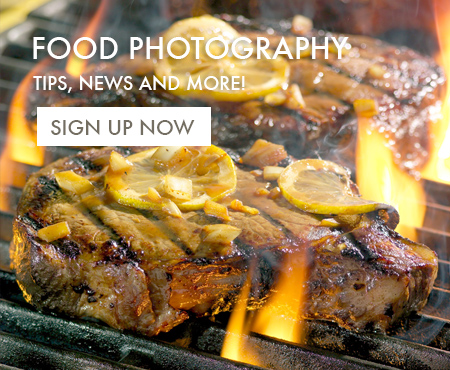 Mixing Light Sources in Food Photography – Q&A
Mixing Light Sources in Food Photography – Q&A
When using more than one light how do you deal with the colour differences.? Do you use a colour temperature meter to check the colour temperature of each light or gel by eye ( guess and by God ) ? Or since they are less powerful than the main light ignore the colour difference they produce. Since some of my lights come from different manufacturers and all have different ages and amounts of use it is something I am aware of. Thanks for continuing my education. Regards Tim
These are some really good questions Tim…
I do have a color temperature meter. I’ve had it for years and keep it in my camera bag all the time. It’s not foolproof though. It’s really good for pointing me in the right direction, but I find it’s not all that good at nailing down the exact color of the light. I use it to get me close and then I use good-old trial and error to get me to where I want to be. The great thing about digital photography is that you can see what you’re doing, as you do it.
Mixing different soft boxes
Lets talk about mixing colors. I shoot food almost exclusively with strobe light. I have recently purchased some LED lights for video, but I still shoot my food photography with strobes. As you know, strobe is balanced for “daylight”, and usually comes close to marching the color of the outdoor light. I say close, because the actual color of daylight, out doors, is constantly changing with the time of day, the amount of cloud cover, and a bunch of other factors.
I’ve experienced the same issues, as you have, using different soft boxes. The material is different from manufacturer to manufacturer and will yellow over time. My boxes were bought a LONG time ago and wouldn’t come close to matching anything bough recently. If I did buy a new soft box and wanted to use it with my old boxes, I’d have to decide whether I wanted to add yellow gels to the new box of blue gels to the old ones. Currently, my very favorite light source is a fresnel spotlight. The color of that light is very different than all my soft boxes and I have to add a bunch of warming gels to the spot so that it will match all my soft boxes. That’s just what you gotta do…
Mixing light on location
When I take my strobes on location for a food shoot, I basically end up with three choices…
Choice #1 – I can overpower all the lights in the environment. If I’m at a restaurant and I’m not actually seeing the interior of the restaurant, but only the table I’m shooting on, I just crank up the shutter speed and totally overpower the ambient light. That way, I’m basically making a studio at the location. I’m not using the ambient light at the location at all, except to see… :o)
Choice #2 – I can live with the color differences. This usually doesn’t work very well. In real life, I’m often in situations where I see food in mixed light situations, but for some reason, it doesn’t usually look right in photos. Having said that, I’ve seen some really cool shots where the highlights of the food have been blue of yellow. But usually, it doesn’t work (watch, after me saying this, it will be the next big trend in food photography! :O)
Choice #3 – My preferred solution for mixing light is to match my strobe to the ambient light. To match with tungsten lighting, this normally requires CTO filters to put over the lamp head. To match fluorescent lights, I add green filters to my strobe. When matching tungsten lights, I usually find it to be a good idea not to totally match the light, but to make my strobes a little bluer than the ambient light. And when I color balance my camera to the strobes, the ambient light in the background. and the fill light, ends up being a little “warmer” by comparison. That warmth usually adds a little “mood” to the shot, but if I didn’t get the lighting close, the warmth would probably be objectionably warm.
A technique I use when mixing light on location for a food shoot is to first block the food from being hit by the ambient light. That lets me light the subject the way I want to, instead of living with what’s there. Road rags are great for this purpose. They are fold-up flags that are easily transportable. If you don’t own these already, I would strongly recommend that you at least look into buying them. They’re a little expensive, but I tell you, you’ll never regret the purchase. I keep mine in my light stand case and they go with me everywhere. They’re great for portraits too. (Get the bigger ones)
That was a great question and I hope that helped. I could use some more questions. I’m getting a little low… (hint – hint…)



good response Michael.
The colour temperature meter is a good starting point but shooting digitally using a grey card for white balance makes getting the “correct” colour temperature for the light more of a breeze.
It is only using different manufacturers light shapers that shows up the problem in the studio.
regards
tim